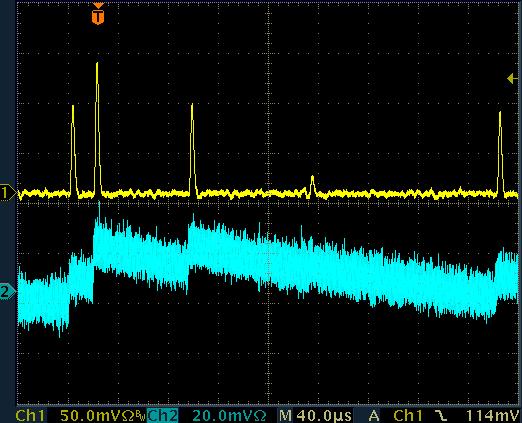The output pulse of a charge sensitive preamplifier (CSP) takes the form of a short rise time (usually less than 1μs) followed by a long exponential decay lasting well in excess of 100μs. If the counting rate approaches 10,000 per second pulses will likely ride on the tail of a previous pulse. This would be a problem when digitizing and recording these pulses as the tail on which the pulse rides would need to be subtracted.
This problem is averted by using a 'shaping amplifier' as the stage following the CSP. Shaping amplifiers perform three functions: First, they provide an output pulse having a much faster return to the baseline than the CSP output pulse. Secondly, shaping amplifiers filter much of the noise from the preamplifier output signal. Finally, shaping amplifiers can also be used to provide extra gain to the signal, which may be very small (sub mV) at the preamplifier output.
In the example below, two oscilloscope traces are shown: the input (blue) and output (yellow) of a shaping amplifier (1μs shaping time) reading pulses from a CSP in the presence of noise. Not only does the shaping amplifier amplify the small pulses, but more importantly the fall time is quickened, greatly reducing the problem of pulses ‘piling up’ on the tails of preceding pulses. Also, the filtering effects of the shaping amplifier significantly filters the noise. This allows for pulses to be clearly detected that would be otherwise completely buried within the noise.

Cremat offers the CR-200 series of shaping amplifier modules. They are available in eight different shaping times: 50ns, 100ns, 250ns, 500ns, 1μs, 2μs, 4μs, and 8μs. We also offer an evaluation board for the CR-200-X series amplifiers (CR-160-R9).
There is an issue not addressed by the CR-200 shaping amplifier modules: At medium to high count rates the output baseline of the shaper stage lowers slightly. This is a consequence of the 'AC coupling" of the preceding amplifier stages by use of blocking capacitors. The blocking capacitors demand that the average-over-time output from the shaping stage must be zero. To address this issue we offer a 'baseline restoration' module: the CR-210.